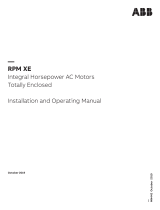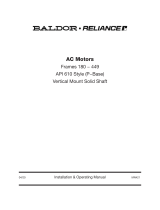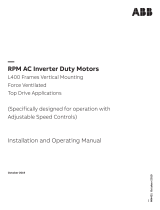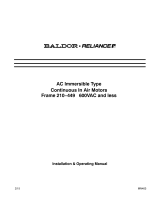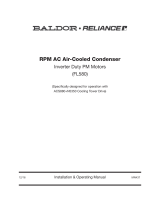Page is loading ...

Oil Mist Lubrication
of AC Motors
Installation & Operating Manual
2/11 MN426

Any trademarks used in this manual are the property of their respective owners.
Important:
Be sure to check www.baldor.com for the latest version of this manual in Adobe Acrobat PDF format.

Table of Contents
Table of Contents iMN426
Section 1
General Information 1−1...............................................................................
Overview 1−1.....................................................................................
Limited Warranty 1−1...............................................................................
Safety Notice 1−1..................................................................................
Receiving 1−2.....................................................................................
Handling 1−2......................................................................................
Storage 1−3.......................................................................................
Preparation for Storage 1−3.....................................................................
Removal From Storage 1−4.....................................................................
Section 2
Installation & Maintenance 2−1.........................................................................
Oil Mist Installation 2−1.............................................................................
Oil Mist Lubrication 2−2.............................................................................

ii Table of Contents MN426

Section 1
General Information
General Information 1−1MN426
Overview This manual contains general procedures that apply to Baldor Motor products. Be sure to read and
understand the Safety Notice statements in this manual. For your protection, do not install, operate or
attempt to perform maintenance procedures until you understand the Warning and Caution statements.
A Warning statement indicates a possible unsafe condition that can cause harm to personnel.
A Caution statement indicates a condition that can cause damage to equipment.
Important: This instruction manual is not intended to include a comprehensive listing of all details for all
procedures required for installation, operation and maintenance. This manual describes general
guidelines that apply to most of the motor products shipped by Baldor. If you have a question
about a procedure or are uncertain about any detail, Do Not Proceed. Please contact your Baldor
distributor for more information or clarification.
Before you install, operate or perform maintenance, become familiar with the following:
S NEMA Publication MG-2, Safety Standard for Construction and guide
for Selection, Installation and Use of Electric Motors and Generators.
S IEC 34−1 Electrical and IEC72−1 Mechanical specifications
S ANSI C51.5, the National Electrical Code (NEC) and local codes and practices.
Limited Warranty
www.baldor.com/support/warranty_standard.asp
Safety Notice: This equipment contains high voltage! Electrical shock can cause serious or fatal injury. Only
qualified personnel should attempt installation, operation and maintenance of electrical equipment.
Be sure that you are completely familiar with NEMA publication MG-2, safety standards for construction
and guide for selection, installation and use of electric motors and generators, the National Electrical
Code and local codes and practices. Unsafe installation or use can cause conditions that lead to serious
or fatal injury. Only qualified personnel should attempt the installation, operation and maintenance of this
equipment.
WARNING: Do not touch electrical connections before you first ensure that power has been disconnected.
Electrical shock can cause serious or fatal injury. Only qualified personnel should attempt the
installation, operation and maintenance of this equipment.
WARNING: Disconnect all electrical power from the motor windings and accessory devices before
disassembly of the motor. Electrical shock can cause serious or fatal injury.
WARNING: Be sure the system is properly grounded before applying power. Do not apply AC power before
you ensure that all grounding instructions have been followed. Electrical shock can cause
serious or fatal injury. National Electrical Code and Local codes must be carefully followed.
WARNING: Avoid extended exposure to machinery with high noise levels. Be sure to wear ear protective
devices to reduce harmful effects to your hearing.
WARNING: Surface temperatures of motor enclosures may reach temperatures which can cause discomfort
or injury to personnel accidentally coming into contact with hot surfaces. When installing,
protection should be provided by the user to protect against accidental contact with hot surfaces.
Failure to observe this precaution could result in bodily injury.
WARNING: This equipment may be connected to other machinery that has rotating parts or parts that are
driven by this equipment. Improper use can cause serious or fatal injury. Only qualified
personnel should attempt to install operate or maintain this equipment.
WARNING: Do not by-pass or disable protective devices or safety guards. Safety features are designed to
prevent damage to personnel or equipment. These devices can only provide protection if they
remain operative.
WARNING: Avoid the use of automatic reset devices if the automatic restarting of equipment can be
hazardous to personnel or equipment.
WARNING: Be sure the load is properly coupled to the motor shaft before applying power. The shaft key
must be fully captive by the load device. Improper coupling can cause harm to personnel or
equipment if the load decouples from the shaft during operation.
WARNING: UL Listed motors must only be serviced by UL Approved Authorized Baldor Service Centers if
these motors are to be returned to a hazardous and/or explosive atmosphere.
WARNING: Thermostat contacts automatically reset when the motor has slightly cooled down. To prevent
injury or damage, the control circuit should be designed so that automatic starting of the motor is
not possible when the thermostat resets.

Section 1
General Information
1−2 General Information MN426
Safety Notice Continued
WARNING: Use proper care and procedures that are safe during handling, lifting, installing, operating and
maintaining operations. Improper methods may cause muscle strain or other harm.
WARNING: Pacemaker danger − Magnetic and electromagnetic fields in the vicinity of current carrying
carrying conductors and permanent magnet motors can result result in a serious health hazard to
persons with cardiac pacemakers, metal implants, and hearing aids. To avoid risk, stay way from
the area surrounding a permanent magnet motor.
WARNING: Before performing any motor maintenance procedure, be sure that the equipment connected to
the motor shaft cannot cause shaft rotation. If the load can cause shaft rotation, disconnect the
load from the motor shaft before maintenance is performed. Unexpected mechanical rotation of
the motor parts can cause injury or motor damage.
WARNING: Do not use non UL/CSA listed explosion proof motors in the presence of flammable or
combustible vapors or dust. These motors are not designed for atmospheric conditions that
require explosion proof operation.
WARNING: Motors that are to be used in flammable and/or explosive atmospheres must display the UL label
on the nameplate along with CSA listed logo. Specific service conditions for these motors are
defined in NFPA 70 (NEC) Article 500.
WARNING: Guards must be installed for rotating parts such as couplings, pulleys, external fans, and unused
shaft extensions, should be permanently guarded to prevent accidental contact by personnel.
Accidental contact with body parts or clothing can cause serious or fatal injury.
Caution: To prevent premature equipment failure or damage, only qualified maintenance personnel should
perform maintenance.
Caution: Do not over tension belts. Excess tension may damage the motor or driven equipment.
Caution: Do not over−lubricate motor as this may cause premature bearing failure.
Caution: Do not lift the motor and its driven load by the motor lifting hardware. The motor lifting hardware
is adequate for lifting only the motor. Disconnect the load (gears, pumps, compressors, or other
driven equipment) from the motor shaft before lifting the motor.
Caution: If eye bolts are used for lifting a motor, be sure they are securely tightened. The lifting direction
should not exceed a 20 angle from the shank of the eye bolt or lifting lug. Excessive lifting
angles can cause damage.
Caution: To prevent equipment damage, be sure that the electrical service is not capable of delivering more
than the maximum motor rated amps listed on the rating plate.
Caution: If a HI POT test (High Potential Insulation test) must be performed, follow the precautions and
procedure in NEMA MG1 and MG2 standards to avoid equipment damage.
If you have any questions or are uncertain about any statement or procedure, or if you require additional
information please contact your Baldor distributor or an Authorized Baldor Service Center.
Receiving
Each Baldor Electric Motor is thoroughly tested at the factory and carefully packaged for shipment. When
you receive your motor, there are several things you should do immediately.
1. Observe the condition of the shipping container and report any damage immediately to the
commercial carrier that delivered your motor.
2. Verify that the part number of the motor you received is the same as the part number listed on your
purchase order.
Handling The motor should be lifted using the lifting lugs or eye bolts provided.
Caution: Do not lift the motor and its driven load by the motor lifting hardware. The motor lifting hardware
is adequate for lifting only the motor. Disconnect the load (gears, pumps, compressors, or other
driven equipment) from the motor shaft before lifting the motor.
1. Use the lugs or eye bolts provided to lift the motor. Never attempt to lift the motor and additional
equipment connected to the motor by this method. The lugs or eye bolts provided are designed to lift
only the motor. Never lift the motor by the motor shaft or the hood of a WPII motor.
2. To avoid condensation inside the motor, do not unpack until the motor has reached room temperature.
(Room temperature is the temperature of the room in which it will be installed).
The packing provides insulation from temperature changes during transportation.
3. When lifting a WPII (Weather Proof Type 2) motor, do not lift the motor by inserting lifting lugs into
holes on top of the cooling hood. These lugs are to be used for hood removal only.
A spreader bar should be used to lift the motor by the cast lifting lugs located on the motor frame.

General Information 1−3MN426
4. If the motor must be mounted to a plate with the driven equipment such as pump, compressor etc.,
it may not be possible to lift the motor alone. For this case, the assembly should be lifted by a sling
around the mounting base. The entire assembly can be lifted as an assembly for installation.
Do not lift the assembly using the motor lugs or eye bolts provided. Lugs or eye bolts are designed to
lift motor only. If the load is unbalanced (as with couplings or additional attachments) additional slings
or other means must be used to prevent tipping. In any event, the load must be secure before lifting.
If the load is unbalanced (as with couplings or additional attachments) additional slings or other
means must be used to prevent tipping. In any event, the load must be secure before lifting.
Storage
Storage requirements for motors and generators that will not be placed in service for at least six months
from date of shipment.
Improper motor storage will result in seriously reduced reliability and failure. An electric motor that does
not experience regular usage while being exposed to normally humid atmospheric conditions is likely to
develop rust in the bearings or rust particles from surrounding surfaces may contaminate the bearings.
The electrical insulation may absorb an excessive amount of moisture leading to the motor winding
failure.
A wooden crate “shell” should be constructed to secure the motor during storage. This is similar to an
export box but the sides & top must be secured to the wooden base with lag bolts (not nailed as export
boxes are) to allow opening and reclosing many times without damage to the “shell”.
Minimum resistance of motor winding insulation is 5 Meg ohms or the calculated minimum, which ever is
greater. Minimum resistance is calculated as follows: Rm = kV + 1
where: (Rm is minimum resistance to ground in Meg−Ohms and
kV is rated nameplate voltage defined as Kilo−Volts.)
Example: For a 480VAC rated motor Rm =1.48 meg−ohms (use 5 M).
For a 4160VAC rated motor Rm = 5.16 meg−ohms.
Preparation for Storage
1. Some motors have a shipping brace attached to the shaft to prevent damage during transportation.
The shipping brace, if provided, must be removed and stored for future use. The brace must be
reinstalled to hold the shaft firmly in place against the bearing before the motor is moved.
2. Store in a clean, dry, protected warehouse where control is maintained as follows:
a. Shock or vibration must not exceed 2 mils maximum at 60 hertz, to prevent the bearings from
brinelling. If shock or vibration exceeds this limit vibration isolation pads must be used.
b. Storage temperatures of 10C (50F) to 49C (120F) must be maintained.
c. Relative humidity must not exceed 60%.
d. Motor space heaters (when present) are to be connected and energized whenever there is a
possibility that the storage ambient conditions will reach the dew point. Space heaters are optional.
Note: Remove motor from containers when heaters are energized, reprotect if necessary.
3. Measure and record the resistance of the winding insulation (dielectric withstand) every 30 days of
storage.
a. If motor insulation resistance decreases below the minimum resistance, contact your Baldor
District office.
b. Place new desiccant inside the vapor bag and re−seal by taping it closed.
c. If a zipper−closing type bag is used instead of the heat−sealed type bag, zip the bag closed
instead of taping it. Be sure to place new desiccant inside bag after each monthly inspection.
d. Place the shell over the motor and secure with lag bolts.
4. Where motors are mounted to machinery, the mounting must be such that the drains and breathers
are fully operable and are at the lowest point of the motor. Vertical motors must be stored in the
vertical position. Storage environment must be maintained as stated in step 2.

1−4 General Information MN426
5. Motors with anti−friction bearings are to be greased at the time of going into extended storage with
periodic service as follows:
a. Motors marked “Do Not Lubricate” on the nameplate do not need to be greased before or during
storage.
b. Ball and roller bearing (anti−friction) motor shafts are to be rotated manually every 3 months and
greased every 6 months in accordance with the Maintenance section of this manual.
c. Sleeve bearing (oil lube) motors are drained of oil prior to shipment.
The oil reservoirs must be refilled to the indicated level with the specified lubricant, (see
Maintenance). The shaft should be rotated monthly by hand at least 10 to 15 revolutions to
distribute oil to bearing surfaces.
d. “Provisions for oil mist lubrication” – These motors are packed with grease. Storage
procedures are the same as paragraph 5b.
e. “Oil Mist Lubricated” – These bearings are protected for temporary storage by a corrosion
inhibitor. If stored for greater than 3 months or outdoor storage is anticipated, connected to the oil
mist system while in storage. If this is not possible, add the amount of grease indicated under
“Standard Condition” in Section 3, then rotate the shaft 15 times by hand. This grease must be
removed when the oil mist system is connected.
6. All breather drains are to be fully operable while in storage (drain plugs removed). The motors must
be stored so that the drain is at the lowest point. All breathers and automatic “T” drains must be
operable to allow breathing and draining at points other than through the bearings around the shaft.
Vertical motors should be stored in a safe stable vertical position.
7. Coat all external machined surfaces with a rust preventing material.
An acceptable product for this purpose is Exxon Rust Ban # 392.
8. Carbon brushes should be lifted and held in place in the holders, above the commutator, by the brush
holder fingers. The commutator should be wrapped with a suitable material such as cardboard paper
as a mechanical protection against damage.
Non−Regreaseable Motors
Non−regreasable motors with “Do Not Lubricate” on the nameplate should have the motor shaft rotated
15 times to redistribute the grease within the bearing every 3 months or more often.
All Other Motor Types
Before storage, the following procedure must be performed.
1. Remove the grease drain plug, if supplied, (opposite the grease fitting) on the bottom of each bracket
prior to lubricating the motor.
2. The motor with regreasable bearing must be greased as instructed in Section 3 of this manual.
3. Replace the grease drain plug after greasing.
4. The motor shaft must be rotated a minimum of 15 times after greasing.
5. Motor Shafts are to be rotated at least 15 revolutions manually every 3 months and additional grease
added every nine months (see Section 3) to each bearing.
6. Bearings are to be greased at the time of removal from storage.
Removal From Storage
1. Remove all packing material.
2. Measure and record the electrical resistance of the winding insulation resistance meter at the time of
removal from storage. The insulation resistance must not be less than 50% from the initial reading
recorded when the motor was placed into storage. A decrease in resistance indicates moisture in the
windings and necessitates electrical or mechanical drying before the motor can be placed into
service. If resistance is low, contact your Baldor District office.
3. Regrease the bearings as instructed in Section 3 of this manual.
4. Reinstall the original shipping brace if motor is to be moved. This will hold the shaft firmly against the
bearing and prevent damage during movement.

Section 2
Installation & Maintenance
Installation & Maintenance 2−1MN426
Oil Mist Installation
1. Remove all grease from bearings. This step is necessary on motors that are labeled ”Provisions for oil
mist lubrication” or motors built for ”oil mist lubrication” but filled with grease by user. This step is not
required on motors built ”For oil mist lubrication” as supplied by factory.
2. Remove inlet and outlet pipe plugs from bearing brackets (or extension tubes) on each end of motor.
3. Install appropriate reclassifier, Tables II. II and IV, in top opening. Connect oil recovery trap to bottom
opening or leave open to act as relief.
Oil Supply
The lubricating oil should be rust and oxidation inhibited, stray−mist suppressed, and manufactured in
accordance with good commercial practice. The viscosity should be ISO VG 100 (approx. 470 sus @
100F), per ASTM D 2422, latest revision. The flash point should not be less than 350F (17 C), nor the
pour point more than −15F (−26C). Oil and misting unit must be compatible. For recommended oils see
Table 1.
TABLE 1
RECOMMENDED OILS
MANUFACTURER OIL NAME
EXXON COMPANY *TERESSTIC*
SYNESSTIC
ENMIST
CHEVRON OIL COMPANY VISTAC
SHELL OIL COMPANY OMALA
TEXACO, INC. TEXAMIST
*This is the only oil recommended above 1000 volts.

2−2 Installation & Maintenance MN426
Oil Mist Lubrication
The following tables should be used to select the appropriate reclassifier based on the motor frame size
and speed. Foot Mounted C & D−Flange Motors as well as Vertical HP Motors use Table II. Vertical LP
Motors refer to Table III.
TABLE II − OIL MIST REQUIREMENTS
FRAME SIZE RATED RPM
BEARING SIZE RRECLASSIFIER SYMBOL* CONSUMPTION @20“ H20
FE BE FE BE OIL** fl oz/hr AIR*** SCFM
180 ALL 205 206 A A .024 .11
210 ALL 206 207 A A .028 .13
250 ALL 309 309 B B .035 .17
280 ALL 310 310 B B .039 .19
320 ALL 311 311 B B .043 .21
360 ALL 313 313 B B .051 .24
400 <1800 316 316 C C .063 .30
3600 313 313 B B .051 .24
440 <1800 318 318 C C .071 .34
3600 313 313 B B .051 .24
5000 <1800 222 222 C C .087 .42
3600 313 313 B B .051 .24
5800 <1800 224 224 C C .094 .45
3600 313 313 B B .051 .24
9500 <1800 226 226 C C .102 .49
3600 220 220 C C .079 .38
TABLE III − VERTICAL LP−BASE
FRAME SIZE RATED RPM
BEARING SIZE RRECLASSIFIER SYMBOL* CONSUMPTION @20“ H20
FE BE FE BE OIL** fl oz/hr AIR*** SCFM
250 ALL 7308 309 B B .035 .17
280 ALL 7309 212 B B .039 .19
320 ALL 7309 213 B B .039 .19
360 ALL 7310 313 B B .051 .24
400 <1800 7314 313 C C .063 .30
3600
7310 313 B B .051 .24
440 <1800 7314 313 C C .063 .30
3600 7310 313 B B .051 .24
TABLE IV
RECLASSIFIER SYMBOL ALEMITE PART NUMBER
A 380791−4
B 380791−6
C 381303−10
* For identification see Table IV − The fittings listed provide consumptions shown in Tables 2 & 3.
** Minimum Oil consumption =
(XX) (5) (0.02)
25.4
+ 0.00394 (XX)
*** Minimum Air consumption = 0.00394 x 4.8 (XX) = .0189(XX)
(XX) Denotes the last 2 digits in bearing identification number on 300 series bearings.

Baldor District Offices

2011 Baldor Electric Company
MN426
All rights reserved. Printed in USA
2/11
World Headquarters
P.O. Box 2400 Fort Smith, AR 72902-2400 USA Ph: (1) 479.646.4711, Fax: (1) 479.648.5792
www.baldor.com
/

